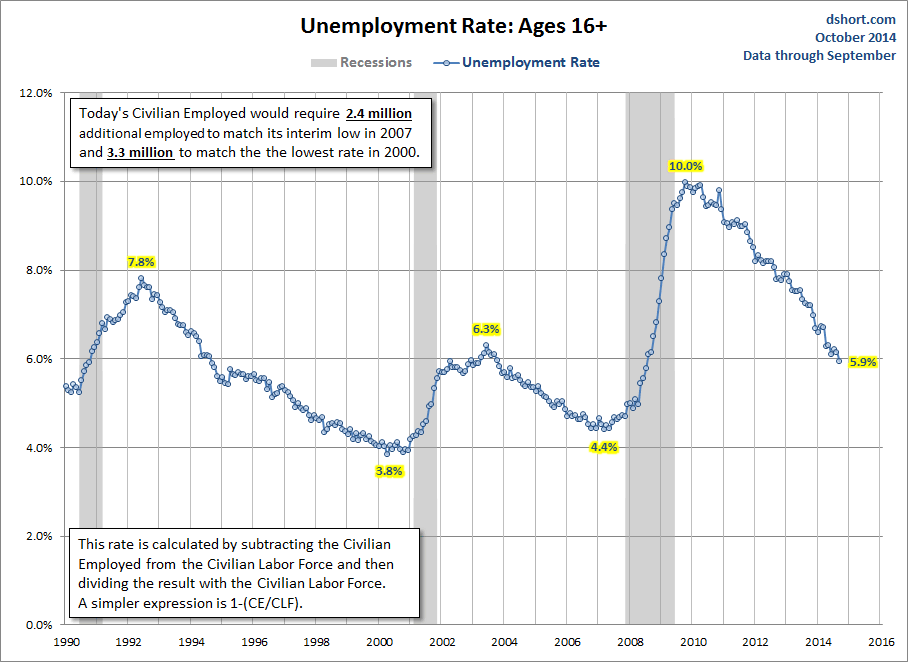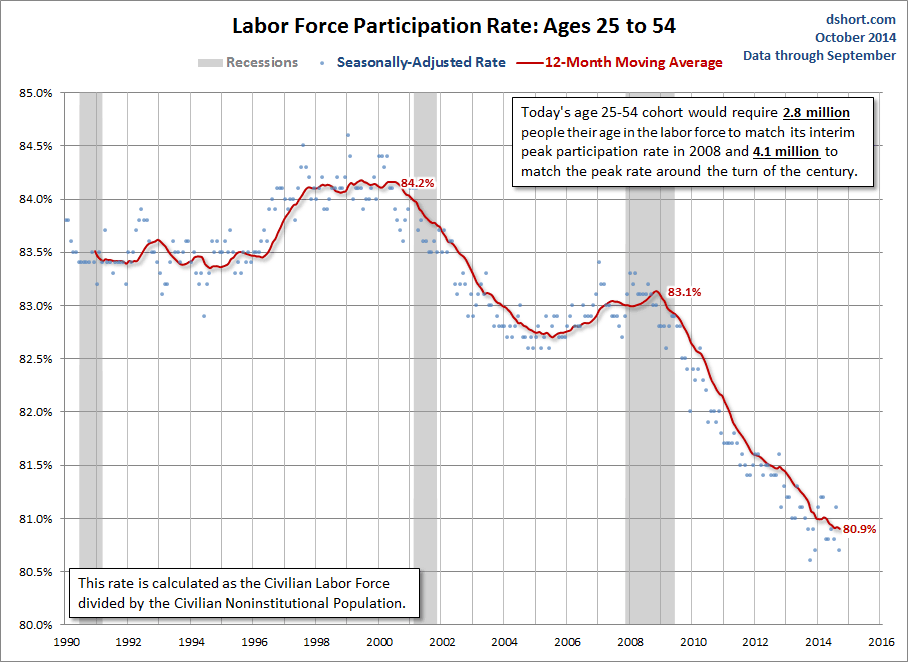In August Fed Chair Janet Yellen delivered an extended analysis of "Labor Market Dynamics and Monetary Policy" at the annual Jackson Hole Symposium. Her speech essentially reviewed the ongoing debate over the cyclical versus structural factors in employment since the Great Recession.
I've updated a series of charts that illustrate structural changes in the workforce that are far more significant than the cyclical impact of a recession — even the so-called "Great Recession".
The Unemployment Rate: Between 2.4 and 3.3 Million Jobs Shy
The closely watched headline unemployment rate is a calculation of the percentage of the Civilian Labor Force, age 16 and older, currently unemployed. The indicator slightly improved in September, dropping from 6.1% to 5.9%. Let's put that into its historical context. The first chart below illustrates this monthly data point since 1990. Today's Civilian Employed would require 2.4 million additional job holders to match its interim low in 2007, and we would need 3.3 million to match the lowest rate in 2000.
Focus on the Prime Employment Age Cohort
Let's look at the same statistic for the core workforce, ages 25-54. This cohort leaves out the employment volatility of the college years, the lower employment of the retirement years and also the age 55-64 decade when many in the workforce begin transitioning to retirement. In September this indicator rose to 4.9% — a new post-recession low. Today's age 25-54 labor force would require the additional employment of 1.5 million age 25-54 to match its interim low in 2006 and 2.0 million to match the lowest rate in 2000.
Labor Force Participation Rate: A More Sobering Measure
A wildcard in the two snapshots above is the volatility of the Civilian Labor Force — most notably the subset of people who move in and out of the workforce for various reasons, not least of which is discouragement during business cycle downturns. The chart below continues to focus on our 25-54 core cohort with a broader measure: The Labor Force Participation Rate (LFPR). The LFPR is calculated as the Civilian Labor Force divided by the Civilian Noninstitutional Population (i.e., not in the military or institutionalized). Because of the extreme volatility of the metric, I've included a 12-month moving average.
Based on the moving average, today's age 25-54 cohort would require 2.8 million additional people in the labor force to match its interim peak participation rate in 2008 and 4.1 million to match the peak rate around the turn of the century. Why are so many more labor force participants needed for a complete LFPR recovery? When the economy is going gangbusters, as in the late 1990s, jobs are abundant, which encourages the population on the workforce sidelines to join the ranks of the employed. Today's economy doesn't offer that sort of encouragement.
Employment-to-Population Ratio: Off Its Post-Recession Low
The next chart below, again focused on our ages 25-54 cohort, is calculated as the Civilian Employed divided by the Civilian Noninstitutional Population. Again I've included a 12-month moving average. A significant feature of the Employment-to-Population Ratio is that isn't affected by the volatility of labor force participants who, for various reasons, are unemployed.
First the good news: This metric began to rebound from its post-recession trough in late 2012. However, the more disturbing news is that the current age 25-54 cohort would require an increase of 4.5 million employed prime-age participants to match its ratio peak in 2007. To match its mid-2000 peak would require a 6.4 million increase.
A Structural Change in the U.S. Economy
The charts above offer strong evidence that our economy is in the midst of a massive structural change. The three mainstream employment statistics — unemployment, labor force participation and employment-to-population — all document an ongoing economic weakness far deeper than the result of a business cycle downturn.
[Read: Proof of a Structural Change in the U.S. Workforce]
In order to discount the general belief that the aging of the baby boom generation is a major factor in weak employment, I have focused on the 25-54 age group. Also, by excluding the age 55-64 decade associated with early or pre-retirement, I've eliminated a cohort that might include a major source of discouraged or less-determined workers.
The Growth of the Elderly Workforce and Its Causes
I'll close this analysis with a chart that essentially demolishes the prevailing view of our aging population as a demographic drag on labor supply. Here is the ratio of the 65-and-over cohort as a percent of the employed civilian population all the way back to 1948, the earliest year of BLS employment data. Mind you … these people are not only in the workforce, but also actually employed.
The percentage of elderly employment is hovering at its historic high — now double its low in the mid-1980s. This is a trend with multiple root causes, most notably longer lifespans, the decline in private sector pensions and frequent cases of insufficient financial planning. Another major cause, I would argue, is the often surprising discovery by many of the elderly that the "golden years of retirement" might be less personally satisfying than productive employment. Note that the growth acceleration began in the late 1990s, prior to the last two business cycle downturns (aka "recessions").
Even Larger Secular Changes
Demographic trends are not the only drivers of a secular shift in employment. the workplace culture is also in the throes of massive technological changes that are dramatically impacting our workplace, as this video clip explains.
In Conclusion…
We are clearly experiencing a structural change in employment, one that is a major drag on the overall economy. The fact this change was exacerbated by a business cycle downturn should not blind us to its structural nature.
Note from dshort: For some related analysis, see the following periodic updates:











